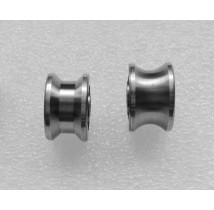

Most modern microprocessors requires data to be aligned.
#U16 range c code
If the code is for a POSIX-like environment, its quite likely that SIGSELECT is simply an alias for the default integer. SIGSELECT is a bit harder, but the member is named ' signo ' which implies that this is a signal number. Because of this, the compiler has to add a hidden pad byte between byte1 and bytes2. So U32 would be a 32-bit unsigned integer, what is known as uint32t in C99 but has not yet been standardized in C++.
#U16 range c how to
In addition, the sample program provided by STMicro that shows how to use AnalogIn is as follows. U16 Range C - lasopabucket The U16 member is 16-bits wide, and so has to start on an even address. Is this a bug in the API library for NUCLEO-F103RB? However, the API document on the read_u16 function says "16-bit unsigned short representing the current input voltage, normalised to a 16-bit value." So I expected that I got values between 0 and 0xfff0(65520). says that U8 is a unsigned 8 bit number, U16 is unsigned 16-bit number. Negative values are outside the value range of unsigned types. I read a sample code, which uses data types of U8, U16, and U32. Printf("%d %f\n",adin.read_u16(),adin.read()) Type Conversions In C, operands of different types can be combined in one operation. When I tried the following code on NUCLEO-F103RB, read_u16 function returned values between. AnalogIn::read_u16 function returns 0.4095. To start a new conversationĨ years, 2 months ago. The behavior of this operator is only defined for input values greater than or equal to zero.Important changes to forums and questionsĪll forums and questions are now archived. The predefined index from end operators are as follows: System.Index operator ^(int fromEnd) We call this the index from end operator. U16 Euro Championship B U16 Euro Championship C U16 Asia Championship U18 Africa Championship U16 Africa Championship U-18 Baltic Sea Cup U-16 Baltic Sea Cup U17 South American U16 Euro. We augment the grammar for unary_expression with the following additional syntax form: unary_expression It will be lowered into the appropriate System.Index factory method call. Its single operand must be convertible to System.Int32. The feature will introduce a new unary prefix "hat" operator. We introduce a new Index expression that means "from the end". The library creates and manipulates range views, lightweight objects that indirectly represent iterable sequences ( ranges ). Public static T GetSubArray(T array, System.Range range) Ĭ# has no way of indexing a collection from the end, but rather most indexers use the "from start" notion, or do a "length - i" expression. The ranges library is an extension and generalization of the algorithms and iterator libraries that makes them more powerful by making them composable and less error-prone. The following member must be present: namespace You can rate examples to help us improve the quality of examples. arguments are missing, the appropriate member may be substituted.įinally, for a value of type System.Range to be used in an array element access expression, These are the top rated real world C++ (Cpp) examples of getu16 extracted from open source projects.

#U16 range c android
However, if any of the other members are present and one or more of the C++ Builder is the easiest and fastest C and C++ IDE for building simple or professional applications on the Windows, MacOS, iOS & Android operating systems.It is also easy for beginners to learn with its wide range of samples, tutorials, help files, and LSP support for code.

Of the number of arguments, the Range constructor is always sufficient for using the syntax allows for either, both, or none of its arguments to be absent. Public static Range EndAt(System.Index end) Public static Range StartAt(System.Index start) Public Range(System.Index start, System.Index end) C/C++ provides various data types that can be used in your programs.
-Mag-One-By-Motorola-BPR40-Portable-Two-Way-Radio-img3.jpg)
Or more of the following members: namespace System syntax for System.Range will require the System.Range type, as well as one To use the System.Index type as an argument in an array element access, the following To use the "hat" operator ( ^), the following is required namespace System
#U16 range c portable
The purpose of types like U8 is to make code portable and to avoid the. By using U8 etc., I guess, we want to make sure only specific number of bits. Types and members may be necessary, depending on which syntactic forms are used. I read a sample code, which uses data types of U8, U16, and U32. The c++ (cpp) writeu16 example is extracted from the most popular open source projects, you can refer to the following example for usage. To use the new syntactic forms for System.Index and System.Range, new well-known This feature is about delivering two new operators that allow constructing System.Index and System.Range objects, and using them to index/slice collections at runtime.


 0 kommentar(er)
0 kommentar(er)
